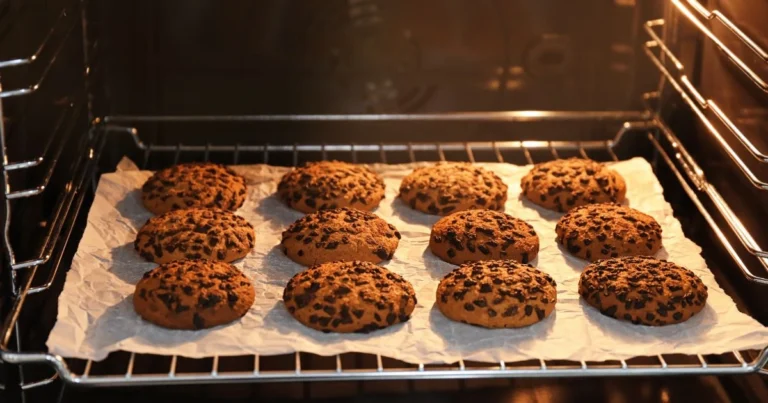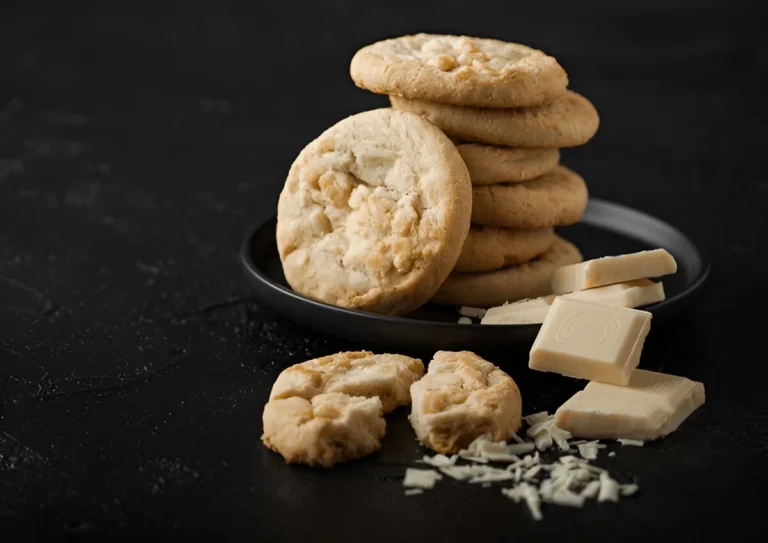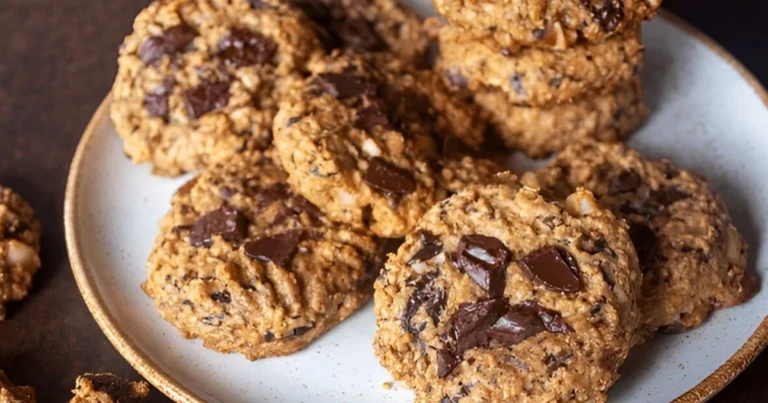Easy Protein Cookies Recipe You Can Bake in Under 20 Minutes
There’s a specific kind of craving we all know – the one that hits when you want something sweet, satisfying, and maybe a little bit indulgent, but without derailing your health goals. It’s that moment when a traditional cookie feels like a delicious, yet slightly regrettable, decision. What if you could silence that craving with a warm, chewy cookie that actually helps you reach your fitness targets? Imagine biting into a freshly baked treat knowing it’s packed with the protein your body craves, all while taking less time to make than it does to decide what to watch on TV. This isn’t a dream; it’s the reality of a quick, easy, and utterly delicious protein cookie, ready in under 20 minutes. Say goodbye to the guilt and hello to your new favorite healthy indulgence!
The Power of Protein: Why These Cookies Are Your New Best Friend
You’ve likely heard about protein’s importance, especially if you’re active or focused on your well-being. But beyond its role in muscle building, protein is a fundamental nutrient with far-reaching benefits for your entire body. Understanding these broader advantages can deepen your appreciation for incorporating more protein into your daily routine, even through delightful means like protein cookies.
Beyond the Gym: Everyday Benefits of Protein
Protein isn’t solely for bodybuilders or elite athletes. It’s an indispensable component for everyone, playing a critical role in myriad bodily functions. When you supply your body with adequate protein, you’re investing in your overall health and vitality.
- Muscle Repair & Growth: Your muscles are constantly undergoing a process of breakdown and repair, particularly after physical activity. Protein provides the necessary amino acids – the “building blocks” – to facilitate this repair, aiding in the growth of lean muscle mass. This isn’t just about gaining bulk; it’s about maintaining strength, mobility, and a healthy metabolism.
- Satiety & Weight Management: Have you ever noticed how a meal rich in protein keeps you feeling full for much longer than one dominated by simple carbohydrates? Protein has a significant impact on satiety, helping to curb hunger pangs and reduce overall calorie intake. This can be a powerful ally in managing your weight effectively, preventing those impulsive snack attacks.
- Energy Levels: While carbohydrates are your body’s primary immediate energy source, protein plays a crucial role in sustained energy. It helps to stabilize blood sugar levels, preventing the drastic peaks and crashes that can leave you feeling fatigued and sluggish. This means more consistent energy throughout your day.
- Bone Health: Many people associate bone health primarily with calcium, but protein is equally vital. It provides the structural framework for bones and supports calcium absorption, contributing to greater bone density and a reduced risk of conditions like osteoporosis, especially as you age.
- Hair, Skin, and Nails: Look at your hair, skin, and nails. What do you see? Protein! These tissues are largely composed of proteins like keratin and collagen. Adequate protein intake is essential for maintaining their strength, elasticity, and overall healthy appearance. Think of it as feeding your beauty from the inside out.
Debunking Protein Myths
Despite its importance, protein is often surrounded by misconceptions. It’s vital to separate fact from fiction to ensure you’re making informed dietary choices. Let’s address a couple of common myths you might encounter.
- Myth: Too much protein is bad for your kidneys. Fact: For healthy individuals with normal kidney function, a moderate to high protein intake is generally safe and well-tolerated. This myth often stems from dietary recommendations for individuals who already have pre-existing kidney disease, where protein intake needs to be carefully managed. If you have no underlying kidney issues, enjoying a protein-rich diet, including delicious protein cookies, is not typically a cause for concern. (Source: Recent meta-analyses of nutritional studies consistently support this.)
- Myth: Protein makes you bulky. Fact: This is a common worry, especially among individuals who are new to focusing on protein intake. While protein supports muscle growth, becoming “bulky” requires a very specific combination of intense resistance training, a calorie surplus, and often, particular genetic predispositions. Eating protein simply helps your body repair and build lean muscle, which contributes to a toned physique, not necessarily a massive one. You won’t accidentally transform into a competitive bodybuilder by enjoying a few more protein cookies!
Your Go-To Protein Cookies Recipe: Quick, Easy, Delicious!
Now that you understand the powerful advantages of protein, are you ready to transform your sweet cravings into a nutritional advantage? This protein cookies recipe is designed for speed and simplicity, ensuring you can enjoy a wholesome treat without lengthy preparation. You’ll be surprised at how effortlessly these come together.
Gather Your Ingredients
The beauty of this recipe lies in its minimal and accessible ingredients. You likely have most of these in your pantry already! Here’s what you’ll need to create your simple, yet satisfying, protein cookies.
| Ingredient | Quantity | Notes |
| Protein Powder | 1/2 cup | Vanilla or unflavored recommended for versatility |
| Oat Flour | 1/4 cup | Rolled oats blended into a fine flour |
| Peanut Butter | 1/4 cup | Natural, unsweetened is best for less sugar |
| Maple Syrup/Honey | 2-3 tbsp | Adjust to your desired level of sweetness |
| Milk (any type) | 2-3 tbsp | Add gradually to achieve desired consistency |
| Vanilla Extract | 1/2 tsp | Enhances overall flavor |
| Baking Powder | 1/4 tsp | For a slightly softer, lighter texture |
| Chocolate Chips | 1/4 cup | Optional, dark chocolate preferred for health benefits |
| Pinch of Salt | Balances sweetness and enhances other flavors |
A quick note on protein powder: For baking, whey protein (concentrate or isolate) generally works very well, yielding a pleasant texture. Pea protein powder is another excellent option, especially if you prefer a plant-based alternative. Avoid casein protein, as it tends to absorb a lot of liquid and can result in a drier, tougher cookie. If using unflavored powder, you might want to slightly increase the vanilla extract or other flavorings.
Step-by-Step Baking Instructions
Follow these straightforward steps, and you’ll have freshly baked protein cookies ready to enjoy in under 20 minutes. It’s genuinely that fast!
- Preheat & Prep: Begin by preheating your oven to a comfortable 350°F (175°C). While the oven heats, take a moment to line a baking sheet with parchment paper. This simple step prevents sticking and makes cleanup a breeze.
- Combine Dry Ingredients: In a medium-sized mixing bowl, bring together all your dry components: the protein powder, oat flour, baking powder, and that essential pinch of salt. Use a whisk to thoroughly combine them, ensuring an even distribution. This prevents any pockets of unmixed ingredients in your final cookie.
- Mix Wet Ingredients: In a separate, smaller bowl, combine the wet ingredients: the peanut butter, maple syrup (or honey), and vanilla extract. Start with 2 tablespoons of your chosen milk. Mix these until you achieve a smooth, homogenous mixture. Its consistency should be fluid enough to easily incorporate into your dry mix.
- Combine All: Now, gently pour the wet mixture into the bowl containing your dry ingredients. Using a sturdy spoon or a rubber spatula, mix everything together until a thick, uniform dough begins to form. This might take a little effort, as the dough will be quite dense. If, after thorough mixing, the dough appears too dry or crumbly to hold together, add the remaining tablespoon of milk, a tiny bit at a time, until the dough comes together cohesively. The goal is a pliable dough that you can easily roll.
- Fold In: If you’re opting for chocolate chips, this is the moment to incorporate them. Gently fold them into the dough until they are evenly dispersed throughout. Overmixing here can activate the gluten in the oat flour and make the cookies tough, so mix just until combined.
- Form Cookies: Take small portions of the dough (about 1 tablespoon each) and roll them into neat 1-inch balls. Place these balls onto your prepared baking sheet. Once all your dough is rolled, use the back of a spoon or your palm to gently flatten each ball slightly. Remember, these cookies won’t spread much during baking, so shape them to your desired thickness and diameter now.
- Bake: Carefully slide your baking sheet into the preheated oven. Bake your protein cookies for approximately 8-12 minutes. Keep a close eye on them; you’re looking for the edges to appear lightly golden and for the cookies to be set in the center. Avoid overbaking, as this can lead to a dry texture.
- Cool: Once baked, remove the baking sheet from the oven. Allow the cookies to cool on the baking sheet for a few minutes. They will continue to firm up as they cool. After a brief cooling period, carefully transfer them to a wire rack to cool completely. This prevents condensation and keeps them from becoming soggy on the bottom.
Customize Your Protein Cookies: Endless Variations
This basic protein cookies recipe is a fantastic starting point, but its true beauty lies in its adaptability. You can easily modify it to suit your taste preferences, dietary needs, or simply to add variety to your snack rotation. Experimenting with different flavors and add-ins ensures you’ll never get bored!
Flavor Boosters & Add-ins
Unleash your culinary creativity! The possibilities for enhancing your protein cookies are virtually limitless.
- Nut Butters: While peanut butter is a classic, don’t hesitate to try other nut butters for distinct flavor profiles. Almond butter offers a milder, slightly sweeter note, while cashew butter provides a creamy richness. Always opt for natural, unsweetened versions to control sugar content.
- Spices: A dash of spice can transform your cookies. Cinnamon adds warmth and a subtle sweetness that pairs wonderfully with many protein powders. Consider nutmeg or even a pinch of pumpkin spice for a seasonal, comforting touch.
- Extracts: Beyond vanilla, explore other extracts. Peppermint extract can create a refreshing, festive cookie, especially when paired with chocolate. Almond extract offers a sophisticated, nutty aroma. Remember that extracts are potent, so a little goes a long way.
- Dried Fruits: For natural sweetness and a delightful chewiness, incorporate dried fruits. Raisins, dried cranberries, or finely chopped apricots are excellent choices. They also add beneficial fiber and antioxidants.
- Nuts & Seeds: Boost texture and nutritional value with chopped nuts like walnuts or pecans. For an omega-3 fatty acid punch, consider adding chia seeds or ground flax seeds – they also help bind the cookies.
- Coconut Flakes: Toasted or untoasted, coconut flakes bring a tropical flair and a pleasant chewiness to your cookies. Toasting them beforehand in a dry pan can intensify their flavor.
Dietary Adjustments for Your Protein Cookies
The versatility of this recipe also extends to accommodating various dietary preferences or restrictions. You can easily tweak it to fit your specific needs.
- Vegan Protein Cookies: Making these cookies vegan is straightforward. Ensure you use a plant-based protein powder (like pea, soy, or a blend), maple syrup as your sweetener, and a plant-based milk (almond, oat, or soy milk work well). Double-check that your chocolate chips are dairy-free; many brands offer excellent vegan options now.
- Gluten-Free Protein Cookies: Since the recipe already uses oat flour, it’s inherently gluten-friendly. However, to ensure they are truly gluten-free for those with celiac disease or severe sensitivities, make sure your protein powder and oat flour are explicitly certified as gluten-free. Cross-contamination can be an issue in manufacturing.
- Lower Sugar Protein Cookies: If you’re mindful of your sugar intake, you can adjust the amount of maple syrup or honey. Start with 2 tablespoons and taste the dough (before adding eggs, if you were using them in another recipe, but this one is egg-free!). You can also experiment with natural sugar substitutes like stevia or erythritol, though these might slightly alter the cookie’s texture and moisture.
Storing Your Protein Cookies for Freshness
You’ve invested time (a very short amount, thankfully!) into making these fantastic protein cookies, so you’ll want to ensure they stay fresh and delicious for as long as possible. Proper storage is key to maintaining their texture and flavor.
Shelf Life and Best Practices
How you store your cookies depends on how quickly you plan to devour them. You have several convenient options:
- Room Temperature: For immediate enjoyment or consumption within a few days, store your protein cookies in an airtight container on your kitchen counter. They will typically remain fresh and delicious for about 3-4 days. An airtight container prevents them from drying out and keeps them soft and chewy.
- Refrigeration: If you wish to extend their freshness, especially in warmer climates or if you’ve added ingredients that might spoil faster (like very ripe bananas if you ever modified the recipe), transferring them to the refrigerator is a great option. Stored in an airtight container, your protein cookies will stay fresh for up to a week in the fridge. Chilled cookies can sometimes have a firmer, chewier texture, which some people actually prefer!
- Freezing: For long-term storage and convenient grab-and-go snacks, freezing is your best friend. Once your cookies have completely cooled, arrange them in a single layer on a baking sheet and place them in the freezer for about 30 minutes to an hour, or until they are firm. This step prevents them from sticking together when you stack them. After they’re firm, transfer the frozen cookies to a freezer-safe bag or container. They will maintain their quality for up to 2-3 months. When you’re ready to enjoy one, simply thaw it at room temperature for a quick snack, or pop it in the microwave for 10-15 seconds for a warm, freshly baked feel.
Conclusion: Savor the Smart Indulgence
You’ve now unlocked the secret to guilt-free indulgence with these incredibly easy protein cookies. No longer do you have to compromise your health goals for a sweet treat. In under 20 minutes, you can whip up a batch of delicious, protein-packed cookies that satisfy your cravings, fuel your body, and keep you steadfastly on track. Whether it’s a critical post-workout refuel, a mid-afternoon energy boost, or a satisfying healthy dessert, these cookies are truly a game-changer for your daily routine.
The beauty of this recipe isn’t just in its speed or its nutritional profile; it’s in the empowerment it gives you. You now have the ability to take control of your snacking, ensuring every bite contributes positively to your well-being. So go ahead, preheat your oven, gather your ingredients, and immerse yourself in the sweet taste of smart nutrition. Your body and your taste buds will thank you.
Ready to transform your snack game? Bake a batch of these easy protein cookies today and discover your new favorite healthy treat! Share your creations and tag us with #EasyProteinCookies!
FAQ: Your Protein Cookies Questions Answered
We understand you might have a few lingering questions about these delightful treats. Here are answers to some of the most common inquiries regarding protein cookies.
How do I make my protein cookies softer?
Achieving that perfectly soft and chewy texture in your protein cookies is all about careful execution.
- Don’t Overbake: This is perhaps the most crucial tip. Baking for less time, closer to the 8-minute mark, will result in a softer cookie. Overbaking draws out too much moisture, leading to a harder, drier result. The cookies will continue to firm up as they cool.
- Adjust Liquid Content: If your dough feels particularly stiff before baking, consider adding an extra splash of milk (1/2 teaspoon at a time) to the dough until it reaches a more pliable, slightly softer consistency.
- Protein Powder Type: The type of protein powder you use can significantly influence texture. Some protein powders absorb more liquid than others. Whey protein often yields a chewier cookie, while some plant-based proteins might result in a denser cookie. Experiment with different brands if you’re consistently getting dry results.
Can I substitute the peanut butter in this protein cookies recipe?
Absolutely! While peanut butter offers a classic flavor and ideal consistency, you have excellent alternatives for your protein cookies.
- Nut Butter Alternatives: Almond butter, cashew butter, or even sunflower seed butter (SunButter) are fantastic substitutes, especially if you have a peanut allergy or simply prefer a different flavor profile.
- Texture Variations: Keep in mind that different nut and seed butters have varying oil contents and textures. You might need to slightly adjust the amount of milk in the recipe when substituting to achieve the perfect dough consistency. Start with the recommended amount of milk and add more if the dough feels too dry.
What is the best type of protein powder for protein cookies?
Choosing the right protein powder is key to successful protein cookies. The best type generally depends on your dietary preferences and desired cookie texture.
- Whey Protein: Whey protein, particularly concentrate or isolate, is a very popular and effective choice for baking. It blends well and tends to result in a pleasant, often chewy, cookie texture. It’s widely available and comes in many flavors.
- Pea Protein: If you prefer a plant-based option, pea protein powder is an excellent alternative. It generally bakes well and can contribute to a softer, more cake-like texture in your protein cookies. Be aware that some pea protein brands might have a slight “earthy” flavor, which can be masked by strong flavors like chocolate or vanilla.
- Avoid Casein: While casein is a milk-derived protein, it’s typically not recommended for baking cookies. Casein absorbs a significant amount of liquid and can lead to a very dry, dense, and sometimes crumbly cookie that isn’t as enjoyable.
- Unflavored vs. Flavored: Unflavored protein powder offers the most versatility, allowing the other ingredients (like peanut butter and vanilla) to shine. However, flavored powders (like vanilla or chocolate) can simplify the flavoring process. Just be mindful of added sugars or artificial sweeteners in flavored powders if that’s a concern for you.







